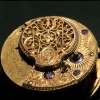Next Video?
-
Recently Browsing
- No registered users viewing this page.
-
Topics
-
Posts
-
Yes that's the type @watchweasol is referring too but I don't like them as you don't get any feel to what's happening.
-
Hi there Stoller, Caliber is generally stamped under the balance or thereabouts. Caliber can't neccessarily be identified by bridge layout. Regs
-
Unless you've got any better suggestions Isn't that what this forum is about? It still depends what state the balance is in to start with.
-
Andy! apparently teaching OP how to build himself a balance complete is upon you. 🤣 lol
-





Recommended Posts